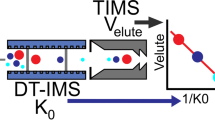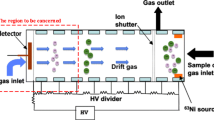Abstract
Ion mobility spectrometry (IMS) is widely used to detect and identify chemical warfare agents, narcotics, and explosives in the field based on their reduced mobility (K 0 ) values. Current detection windows for these analytes can only be as narrow as ±2% of the K 0 values for the analyte being sought. These wide detection windows cause false positive alarms when an interferent with a similar reduced mobility falls within the detection window and triggers an alarm. This results in the loss of time and money as resources are diverted to verify the alarm. A high rate of false positive alarms is caused by a discrepancy in the reported K 0 values across the literature that is, at best, ± 2% of the average available values. By accurately and precisely measuring the variables affecting an ion’s K 0 value, an accurate K 0 value can be produced and the detection windows widths that are established using these reference values can be reduced. Components for accurate analyses have been assembled in the past and here the construction of an accurate ion mobility spectrometry drift tube is described that is accurate to 0.1% of the calculated K 0 value and can be hermetically sealed without inserting the drift tube into a large vacuum chamber. Having a pressure sealed accurate ion mobility spectrometer will allow for the control of the pressure variable within the K 0 equation and the safe analysis of hazardous chemicals. Here the construction of an inexpensive and easily reparable sealed drift tube is described.






Similar content being viewed by others
References
Eiceman GA, Stone JA (2004) Ion mobility spectrometers in National Defense. Anal Chem 76(21):390A–397A
Zulatov YA (2006) Ion mobility Speectrometry. J Anal Chem 61(6):519–519
Clemmer DE, Jarrold MF (1997) Ion mobility measurements and their applications to clusters and biomolecules. J Mass Spectrom 32:577–592
Crawford CL, Hauck BC, Tufariello JA, Harden CS, McHugh V, Siems WF, Hill HH Jr (2012) Accurate and reproducible ion mobility measurements for chemical standard evaluation. Talanta 101:161–170
Buxton TL, Harrington P d B (2001) Rapid multivariate curve resolution applied to identification of explosives by ion mobility spectrometry. Anal Chim Acta 434(2):269–282
CBRNE Tech Index. http://www.cbrnetechindex.com/p/3330/Morpho-Detection-Inc/Hardened-MobileTrace-HMT. Accessed Oct 2017
CBRNE Tech Index. http://www.cbrnetechindex.com/p/4249/Smiths-Detection-Inc/MMTD-Multi-Mode-Threat-Detector. Accessed Oct 2017
TSA Year in Review: Record amount of Firearms Discovered in 2016. https://www.tsa.gov/blog/2017/01/12/tsa-year-review-record-amount-firearms-discovered-2016. Accessed Oct 2017
Kanu AB, Haigh PE, Hill HH Jr (2005) Surface detection of chemical warfare agent simulants and degradation products. Anal Chim Acta 553:148–159
Fernández-Maestre R, Harden CS, Ewing RG, Crawford CL, Hill HH Jr (2010) Chemical standards in ion mobility spectrometry. Analyst 135(6):1433–1442
Eiceman GA, Nazarov EG, Stone JA (2003) Chemical standards in ion mobility spectrometry. Anal Chim Acta 493:185–194
Ochoa ML, Harrington PB (2004) Detection of methamphetamine in the presence of nicotine using in situ chemical derivatization and ion mobility spectrometry. Anal Chem 76:985–991
Rearden P, Harrington PB (2005) Rapid screening of precursor and degradation products of chemical warfare agents in soil by solid-phase microextraction ion mobility spectrometry (SPME-IMS). Anal Chim Acta 545(1):13–20
Kaur-Atwal G, O'Connor G, Aksenov AA, Bocos-Bintintan V, Thomas CLP, Creaser CS (2009) Chemical standards for ion mobility spectrometry: a review. Int J Ion Mobil Spectrom 12:1–14
Spangler GE, Carrico JP, Campbell DN (1985) Recent advances in ion mobility spectrometry for explosives vapor detection. J Test Eval 13(3):234–240
Asbury GR, Klasmeier J, Hill HH Jr (2000) Analysis of explosives using electrospray ionization/ion mobility spectrometry (ESI/IMS). Talanta 50:1291–1298
Ewing RG, Miller CJ (2001) Detection of volatile vapors emitted from explosives with a handheld ion mobility spectrometer. Field Anal. Chem Technol 5(5):215–221
Ewing RG, Atkinson DA, Eiceman GA, Ewing GJ (2001) A critical review of ion mobility spectrometry for the detection of explosives and explosive related compounds. Talanta 54:515–529
Fetterolf DD (1993) Detection of trace explosive evidence by ion mobility spectrometry. In: Yinon J (Ed) Advances in Analysis and Detection of Explosives, Proceedings of the 4th international symposium on analysis and detection of explosives, Jerusalem, Israel, September 7–10, 1992. Kluwer Academic Publishers, Dordrecht, pp 117–132
Buttigieg GA, Knight AK, Denson S, Pommier C, Denton B (2003) Characterization of the explosive triacetone triperoxide and detection by ion mobility spectromtery. Forensic Sci Int 135:53–59
Tam M, Hill HH Jr (2004) Secondary electrospray ionization-ion mobility spectrometry for explosive vapor detection. Anal Chem 76:2741–2747
Lai H, Leung A, Magee M, Almirall JR (2010) Identification of volatile chemical signatures from plastic explosives by SPME-GC/MS and detection by ion mobility spectrometry. Anal Bioanal Chem 396:2997–3007
Crawford CL, Hill HH Jr (2013) Evaluation of false positive responses by mass spectrometry and ion mobility spectrometry for the detection of trace explosives in complex samples. Anal Chim Acta 795:36–43
Asbury GR, Wu C, Siems WF, Hill HH Jr (2000) Separation and identification of some chemical warfare agent degradation products using electrospray high resolution ion mobility spectrometry with mass selected detection. Anal Chim Acta 404:273–283
Steiner WE, Clowers BH, Matz LM, Siems WF, Hill HH Jr (2002) Rapid screening of aqueous chemical warfare agent degradation products: ambient pressure ion mobility mass spectrometry. Anal Chem 74:4343–4352
Steiner WE, Klopsch SJ, English WA, Clowers BH, Hill HH Jr (2005) Detection of a chemical warfare agent simulant in various aerosol matrixes by ion mobility time-of-flight mass spectrometry. Anal Chem 77:4792–4799
Steiner WE, Harden CS, Hong F, Klopsch SJ, Hill HH Jr, McHugh VM (2006) Detection of aqueous phase chemical warfare agent degradation products by negative mode ion mobility time-of-flight mass spectrometry [IM(tof)MS]. J Am Soc Mass Spectrom 17:241–245
Hauck BC, Davis EJ, Clark AE, Siems WF, Harden CS, McHugh VM, Hill HH Jr (2014) Determining the water content of a drift gas using reduced ion mobility measurements. Int J Mass Spectrom 368:37–44
Hauck BC, Siems WF, Harden CS, McHugh VM, Hill HH Jr (2016) E/N effects on K 0 values revealed by high precision measurements under low field conditions. Rev Sci Instrum 87:075104
Hauck BC, Siems WF, Harden CS, McHugh VM, Hill HH Jr (2017) Determination of E/N influence on K 0 values within the low field region of ion mobility spectrometry. J Phys Chem A 121:2274–2281
Fernández-Maestre F (2017) Calibration of the mobility scale in ion mobility spectrometry: the use of 2,4-lutidine as a chemical standard, the two-standard calibration method and the incorrect use of drift tube temperature for calibration. Anal Methods 9:4288–4292
Acknowledgments
Funding for this research was initially provided in part by Science Applications International Corporation, now LEIDOS, as a subcontract under a Task Order contract with U.S. Army Edgewood Chemical Biological Center and has been continued with the U.S. Army Research Office under grant #W911NF-12-1-0575. The construction of the IMS instrument would not have been possible without the expertise, skilled labor, and advice from Dave Savage, Lauren Frei, Steve Watson, and Fred Schutze of Washington State University’s Technical Services Instrument and Electronics shops.
Author information
Authors and Affiliations
Corresponding author
Rights and permissions
About this article
Cite this article
Hauck, B.C., Siems, W.F., Harden, C.S. et al. Construction and evaluation of a hermetically sealed accurate ion mobility instrument. Int. J. Ion Mobil. Spec. 20, 57–66 (2017). https://doi.org/10.1007/s12127-017-0224-9
Received:
Revised:
Accepted:
Published:
Issue Date:
DOI: https://doi.org/10.1007/s12127-017-0224-9




